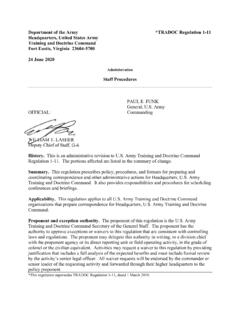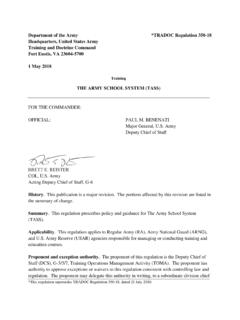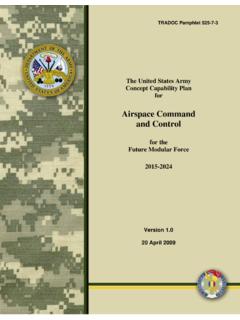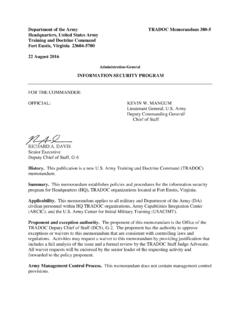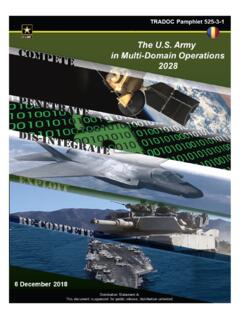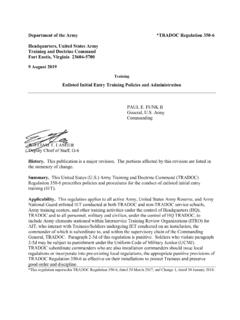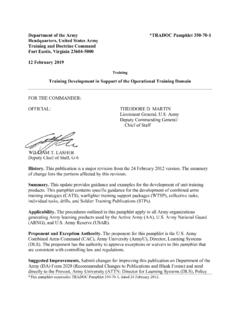Transcription of FOR THE COMMANDER: OFFICIAL
1 Department of the Army TRADOC Pamphlet 350-70-14. Headquarters, United States Army Training and Doctrine Command Fort Eustis, Virginia 23604-5700. 27 March 2015. Training TRAINING AND EDUCATION DEVELOPMENT IN SUPPORT OF THE. INSTITUTIONAL DOMAIN. FOR THE COMMANDER: OFFICIAL : KEVIN W. MANGUM. Lieutenant General, USA. Deputy Commanding General/. Chief of Staff RICHARD A. DAVIS. Senior Executive Deputy Chief of Staff, G-6. History. This publication is a new Army Training and Doctrine Command (TRADOC). pamphlet. Summary. This pamphlet contains specific guidance for the development of courses and lessons, with supporting information on analyses, assessment, job aids and graphic training aids, training support packages, and training and education management.
2 It provides guidance and examples for organizations that develop training and education products for the institutional training domain. This guidance and these examples use the process and concepts outlined in the Army Learning model (ALM) and support the development of both task-based and education-based lessons. Applicability. The procedures outlined in this pamphlet apply to all Army organizations generating Army learning products used by the Active Army (AA), Army National Guard (ARNG), Army Reserve (USAR), and Department of the Army (DA) Civilians.
3 When there is a conflict between this pamphlet and TRADOC Pamphlet 350-70-7 in the development of learning products for Professional Military Education (PME), the following organizations will have TRADOC Pamphlet 350-70-7 take precedence: Army War College (AWC), Command and General Staff College (CGSC), The Western Hemisphere Institute for Security Cooperation (WHINSEC), Warrant Officer Career College (WOCC), Army TRADOC Pamphlet 350-70-14. Sergeants Major Academy (USASMA), and The Defense Language Institute Foreign Language Center (DLIFLC also known as DLI).
4 Proponent and exception authority. The proponent for this pamphlet is the Army Combined Arms Command (CAC), Training Management Directorate (TMD). The proponent has the authority to approve exceptions or waivers to this pamphlet that are consistent with controlling law and regulations. Suggested Improvements. Users are invited to send comments and suggested improvements on DA Form 2028 (Recommended Changes to Publications and Blank Forms). directly to the Commander, Combined Arms Center, Training Management Directorate (ATZL-CTD), Fort Leavenworth, KS 66027-2300; or electronically to Suggested improvements may also be submitted using DA Form 1045 (Army Ideas for Excellence Program (AIEP) Proposal).
5 Distribution. This TRADOC pamphlet is available only on the TRADOC website Summary of Change TRADOC Pamphlet 350-70-14. Training and Education Development in Support of the Institutional Domain This pamphlet, dated 27 March 2015- o provides how to guidance for institutional domain training and education product development and management using the analysis, design, development, implementation, evaluation process (throughout). o implements the Army Learning model using guidance and examples (throughout). o provides various product formats, checklists, and supporting information which support the developer in producing quality institutional training and education products (Appendices).
6 2. TRADOC Pamphlet 350-70-14. Contents Page Chapter 1 Introduction .. 9. 1-1. Purpose .. 9. 1-2. References .. 9. 1-3. Explanation of abbreviations and terms .. 9. 1-4. Scope .. 9. 1-5. Army learning policy and systems overview .. 9. 1-6. Institutional learning processes and products .. 9. 1-7. Army learning policy and systems and the analysis, design, development, implementation, evaluation (ADDIE) process .. 11. 1-8. Regulation and pamphlet 14. Chapter 2 Proponent Responsibilities and Support of Institutional Training and Education Products .. 15.
7 2-1. Introduction .. 15. 2-2. Training proponent information and identification (ID) 15. 2-3. Institutional training and education system .. 15. 2-4. Mandatory training in institutions .. 16. 2-5. Foreign disclosure (FD) restriction statements .. 16. 2-6. Copyright/proprietary materials/intellectual property .. 16. 2-7. Training development management .. 18. 2-8. Interfacing with other Army systems and processes .. 18. 2-9. Application of the Army Learning model (ALM) .. 18. Chapter 3 Operational Force Drivers of Generating Force Learning Products.
8 20. 3-1. Introduction .. 20. 3-2. Needs analysis .. 20. 3-3. Learning product analysis process overview .. 28. 3-4. Mission analysis .. 28. 3-5. Safety and environmental protection .. 29. Chapter 4 Job 30. 4-1. Introduction to job analysis .. 30. 4-2. The job analysis process .. 30. 4-3. Individual task identification .. 32. 4-4. The total job task inventory .. 33. 4-5. Identifying potential critical tasks .. 34. 4-6. Critical task and site selection boards (CTSSB) .. 34. 4-7. The individual critical task list (ICTL) .. 35. 4-8. Individual task analysis.
9 36. 4-9. The critical-individual task-to-lesson matrix .. 37. Chapter 5 Target Audience Analysis .. 37. 5-1. Introduction of target audience analysis .. 37. 5-2. Data collection planning .. 38. 5-3. Determine population size, location, and availability .. 38. 5-4. Develop data collection 39. 5-5. Data collection .. 41. 5-6. Data analysis procedure .. 42. 5-7. Review goals and 42. 3. TRADOC Pamphlet 350-70-14. 5-8. Determine reliability and validity of raw data .. 42. 5-9. Prepare analysis data .. 43. 5-10. Analyze data .. 43. 5-11. Interpret findings.
10 45. 5-12. Target audience analysis for students in attendance .. 45. Chapter 6 46. 6-1. Introduction to courses .. 46. 6-2. Analysis .. 47. 6-3. Course design considerations .. 47. 6-4. Course design 49. 6-5. Course purpose and scope .. 50. 6-6. Course prerequisites .. 50. 6-7. Structure and sequence .. 51. 6-8. Course development .. 53. 6-9. Course management plan (CMP) .. 54. 6-10. Lesson design and development .. 54. 6-11. Individual student assessment plan (ISAP) .. 54. 6-12. Course map and course schedule .. 56. 6-13. Course length .. 59. 6-14.
